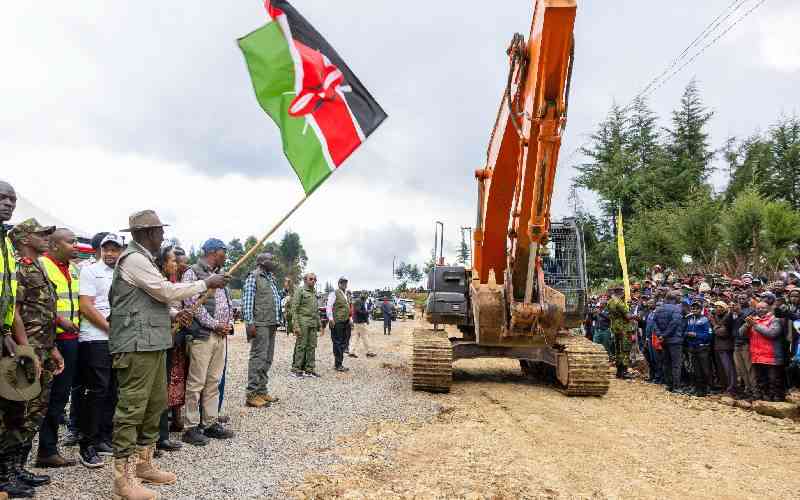President William Ruto launches construction of the 12km Kinamba-Murinduku road, Kuresoi North, Nakuru County, on October 27, 2025. [PCS]
In recent years, public discourse around government spending and infrastructure development has often been a contentious topic. A clown once claimed, “we don’t eat roads,” implying that investments in roads and infrastructure are a waste of money.
Such sentiments overlook the fact that, indeed, we do “eat roads” — they sustain our economies, connect communities, and drive national progress. Roads are the arteries of any nation, and their significance cannot be overstated. When government officials talk about infrastructural projects, they are talking about laying the backbone for economic growth. The ongoing discussions surrounding dualisation of the Rironi-Nakuru-Mau Summit road exemplify this point. If, as the President has asserted, this project is completed, it promises to be a game-changer—not only for people of the Rift Valley but for the entire region.
This road is a critical corridor linking Kenya to neighbouring countries such as Uganda, Rwanda, Burundi, South Sudan, and the Democratic Republic of Congo. This route facilitates cross-border trade, enabling goods and services to flow more freely. For businesspeople operating within the East African Community, a modern, dual carriageway will mean smoother transportation, reduced travel time, and lower costs—factors that directly boost trade and regional integration.
Follow The Standard
channel
on WhatsApp
In my personal experience, traveling along these routes over the past year has been eye-opening. Comparing the roads connecting Nakuru to Nairobi and Nakuru to Nyeri is like comparing life and death. The one to Nyeri has significantly improved, well-maintained, smooth and reliable. As a frequent traveler to Central, I can attest that the quality of these roads has transformed long, arduous journeys into pleasant drives. This progress is not just a matter of comfort; it’s a catalyst for economic activity, tourism and social cohesion. However, the journey to Nakuru onwards presents a stark contrast. Heavy traffic congestion, worsened by thousands of trucks ferrying goods across the region, turns what should be a straightforward drive, into a torturous ordeal. People have spent 24 hours to cover the 160km to Nakuru city.
This bottleneck underscores why infrastructure investments are critical. Rift Valley, Kenya’s breadbasket, plays an essential role in feeding Nairobi, Mombasa, and beyond. It produces some of the country’s leading export commodities, notably tea — Kenya’s emblematic export product that must be transported to Mombasa for export. An efficient road network would streamline this process, ensuring produce reaches markets faster and fresher.
Sometimes back, Kinangop, one of the most productive areas in Kenya was totally soaked in mud. During the rainy seasons, access to highly productive farms was a nightmare, with only tractors able to navigate the muddy, treacherous terrain. This situation led to wastage of perishable produce and economic losses for farmers. A friend once confided in me that he had planted ten thousand cabbages but sold only thirty. Yes, thirty cabbages.
The primary reason? Poor road infrastructure and market access. Such stories highlight that roads are not merely about convenience — they are about livelihoods. When farmers cannot get their produce to market efficiently, they lose income, and overall food security is compromised. Once the main arteries in Kinangop were fixed, the farmers today get better prices for their produce.
The broader implication is clear: infrastructural development, especially road expansion and improvement, holds the key to unlocking Kenya’s economic potential. It’s about opening up markets, reducing transportation costs, and fostering regional cooperation. What must be emphasised is that these investments in infrastructure are not mere expenditures—they are investments in our future. They create jobs during construction, boost local economies, and pave the way for technological and industrial growth. The roads we build today will determine the economic landscape of tomorrow. It’s high time we see roads not as waste of money but as the foundation of our nation’s success.
Infrastructure development is an integral part of nation-building. Indeed, we should be eating roads for breakfast, lunch and dinner.
–The writer is a communications consultant
Follow The Standard
channel
on WhatsApp
By Mutahi Mureithi


